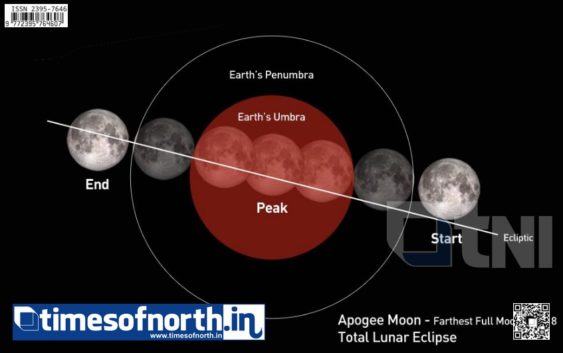- Siliguri’s Punit Biswas Shines in Asian Youth TT Championship
- Rare Encounter: Leopard Cub Roam Free Inside SSB Camp in Malbazar
- Royal Bengal Tigers Spotted Again in Buxa Jungle
- No Work Elsewhere: Workers Returns to File Complaint Against TG Manager
- Giant Royal Bengal Tiger Captured at Neora Valley of North Bengal
Longest total Lunar Eclipse of 21st Century Plus to be Visible Tomorrow

TNI News Service (TNS)
Webdesk, TNI Siliguri 26th July, 2018: Earthlings are about to witness a rarest of the rare kind of event in the sky on 27th July 2018 longest lunar eclipse in 21st century with totality of 103 minutes. This will coincide with great naked eye sight of the parade of 5 planets in the sky- Mercury, Venus, Jupiter, Saturn and Mars. This eclipse will be the second total lunar eclipse in 2018, after the one in January. According to a press release Sky Watchers’ Association of North Bengal (SWAN) is on preparation for the event since last one year. So far, we have covered more than 18 academic camps with total participation of over 1800 students with technical details of the event. In addition, we have been preparing our instruments and brushing up our own skill level to conduct our own technical observation and data recording of the event for scientific purpose. But, as it is peak Monsoon, probability of having a clear sky is too grim. Since 2000, Siliguri remained under thick cloud almost every year on this date. That prompted us to spread out our activity. All our members or friends will take initiative to watch the event from their own places. We encourage everyone to do so instead of gathering at a common place. In that way, even if one misses the event due to localized cloud cover, someone else will get it. Date of the Total Lunar Eclipse falls within a time window of couple of days when many planets will be bright enough and close enough to be visible together in the sky even with naked eye. Moreover, Red planet MARS will be at its closest to Earth during 27th to 31st July. The bright planets, Venus, Jupiter, Saturn, Mars, in a line in the sky will appear as in a Great Planetary Parade. Right after Sunset on the day, Mercury, though faint, will be visible in the West. This will be followed by Venus hanging in the west with eye-catching brilliance. In the mid sky, there will be Jupiter, to be followed by Saturn. Mars, with its distinct red colour will come visible in Eastern Sky After around 9:00pm.
Photo Source: As sent by SWAN
